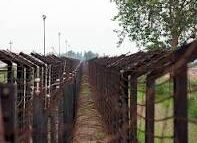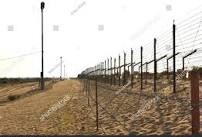Introduction:
The India-Pakistan border, a geopolitical hotspot, has been a source of contention and conflict since the partition of British India in 1947. This 3,323-kilometer-long border, often referred to as the Radcliffe Line, separates the two South Asian neighbors, India and Pakistan. The history of the region, marked by territorial disputes, wars, and ongoing tensions, has shaped the complex dynamics of the border. This article aims to explore the historical context, contemporary challenges, and the ongoing efforts to foster peace in this volatile region.
India-Pakistan Border Historical Roots
The roots of the India-Pakistan border conflict can be traced back to the partition of British India in 1947, which led to the creation of two independent states, India and Pakistan. The demarcation of the border, known as the Radcliffe Line, was hastily drawn by British lawyer Sir Cyril Radcliffe, who had little knowledge of the region’s complexities. The arbitrary division of provinces and regions along religious lines resulted in the displacement of millions and ignited communal tensions.
India-Pakistan Border
The first major conflict between India-Pakistan Border occurred shortly after independence in 1947-1948 over the princely state of Jammu and Kashmir. This territorial dispute laid the groundwork for subsequent conflicts and set the tone for a strained relationship between the two nations.
Wars and Conflicts:
The India-Pakistan border has witnessed several wars and conflicts, each contributing to the deep-seated animosity between the two countries. The Indo-Pakistani Wars of 1947-48, 1965, and 1971, as well as the Kargil conflict in 1999, have left an indelible mark on the region. The Line of Control (LoC) in Jammu and Kashmir, a de facto border, has been a constant flashpoint, with both nations claiming the entire territory.
The 1971 war, which led to the creation of Bangladesh, further strained relations between India and Pakistan. The legacy of these conflicts continues to shape the geopolitics of the region and contributes to the challenges faced along the India-Pakistan border.

Contemporary Challenges:
The contemporary challenges along the India-Pakistan border are multifaceted and include issues of territorial disputes, cross-border terrorism, water-sharing, and diplomatic tensions. The Line of Control remains a volatile region, with frequent skirmishes and ceasefire violations, causing casualties on both sides.
The issue of terrorism has been a persistent challenge, with India accusing Pakistan of supporting and harboring terrorist groups operating in the region. The 2008 Mumbai attacks and the 2016 Uri attack heightened tensions and led to increased militarization along the border.
Water-sharing remains a contentious issue, particularly regarding the Indus Water Treaty. The rivers flowing from India to Pakistan are a crucial resource for both countries, and disputes over water usage further complicate the bilateral relationship.
Diplomatic efforts to resolve these challenges have often been hindered by deep-rooted mistrust and divergent national interests. International interventions, including those by the United Nations, have had limited success in mediating the longstanding disputes.
Cross-Border Migration and Humanitarian Concerns:
The India-Pakistan border has witnessed significant cross-border migration, with communities on both sides experiencing the impact of partition and subsequent conflicts. The people living in border areas face unique challenges, including displacement, disrupted livelihoods, and the constant threat of violence.
The issue of prisoners of war and civilians detained on both sides adds a humanitarian dimension to the conflict. Efforts to repatriate prisoners and address the plight of affected communities have been sporadic, reflecting the broader complexities of the Indo-Pak relationship.
Peace Initiatives and Diplomatic Dialogues:
Despite the historical animosity and contemporary challenges, both India and Pakistan have engaged in diplomatic initiatives to address the issues along their border. Numerous peace talks and dialogues have taken place over the years, with varying degrees of success.
The Simla Agreement of 1972, signed after the 1971 war, aimed at normalizing relations and resolving outstanding issues through bilateral negotiations. However, subsequent events and conflicts have often derailed these efforts.
The Lahore Declaration of 1999, a significant step towards peace, was overshadowed by the Kargil conflict that followed shortly after. The composite dialogue process initiated in the early 2000s sought to address various issues, including Kashmir, but progress has been slow and subject to interruptions.
The Agra Summit in 2001 and the Islamabad Summit in 2004 were other notable attempts to improve relations, but they did not lead to substantial breakthroughs. Track-II diplomacy and backchannel talks have also played a role in fostering communication between the two nations during periods of heightened tensions.
The Role of International Actors:
International actors, including the United States, China, and various European nations, have periodically attempted to mediate and facilitate dialogue between India and Pakistan. The United Nations has been involved in peacekeeping efforts, particularly in the context of the Kashmir conflict.
The role of international actors, however, is limited by the bilateral nature of the disputes and the deep-seated mistrust between the two countries. The geostrategic significance of the region also complicates external involvement, as global powers navigate their own interests in South Asia.
Challenges to Regional Stability:
The India-Pakistan border conflict has broader implications for regional stability in South Asia. The nuclear capabilities of both nations add an alarming dimension to the tensions, raising concerns about the potential for a nuclear conflict.
The impact of the conflict extends beyond the immediate border region, affecting the socio-economic development of both nations. Military expenditures, border security measures, and the allocation of resources for defense often come at the expense of social welfare and economic progress.
The Role of Public Opinion:
Public opinion in both India-Pakistan Border plays a crucial role in shaping the narrative surrounding the border conflict. Nationalistic sentiments, historical grievances, and media portrayals contribute to the perpetuation of hostilities.
Civil society initiatives, people-to-people contact, and cultural exchanges have, at times, served as positive elements in fostering understanding and goodwill between the two nations. However, the influence of hawkish elements and political considerations often overshadow these grassroots efforts.
The Path Forward: Towards Sustainable Peace:
Resolving the complex issues along the India-Pakistan border requires a multifaceted approach addressing historical grievances, territorial disputes, cross-border terrorism, and water-sharing concerns. A sustained commitment to diplomatic dialogue, confidence-building measures, and people-to-people contact is essential.
- Bilateral Diplomacy: Both India Pakistan Border need to demonstrate political will and engage in sustained bilateral diplomacy. Resuming and institutionalizing a comprehensive dialogue process that addresses all outstanding issues is crucial.
- Confidence-Building Measures: Implementing confidence-building measures, such as reducing military presence along the border, implementing ceasefires, and cooperating on counter-terrorism efforts, can help create an atmosphere conducive to peace.
- People-to-People Contact: Encouraging people-to-people contact through cultural exchanges, educational programs, and business collaborations can help bridge the gap between the two nations. Civil society initiatives that promote dialogue and understanding should be supported.
- International Mediation: While respecting the bilateral nature of the conflict, international actors can play a constructive role in facilitating dialogue and encouraging confidence-building measures. The United Nations and regional organizations can provide platforms for mediation.
- Economic Cooperation: Exploring avenues for economic cooperation and regional integration can create shared interests that contribute to stability.


